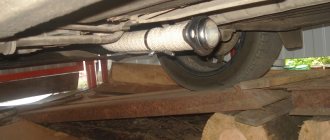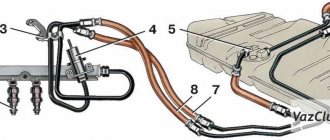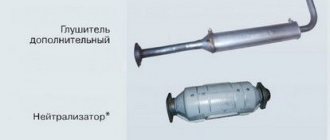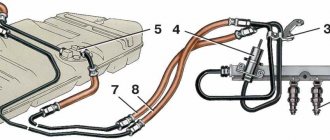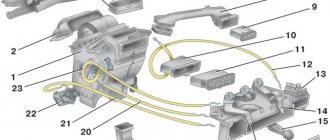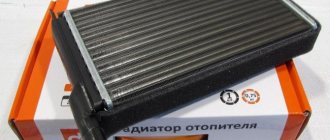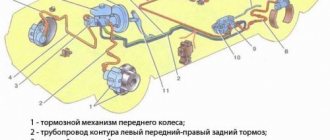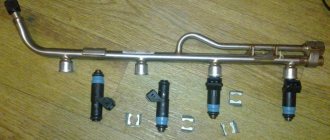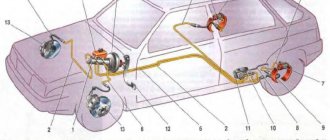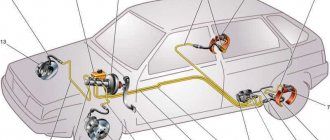We continue to prepare for the summer season!
I couldn’t resist, I wanted to show some nice things) a little out of plan, but such chic things cannot be hidden)
I've been wanting a new exhaust system for a long time. The standard has long since exhausted itself, the ringing of metal began and there was a constant knocking on the bottom, in the area of the rear passengers, it seemed to be knocking on the beam. In short, I'm fed up with this standard. I bought all kinds of rubber bands and put iron clamps in their place, the knocking noise disappeared for a while, then it appeared again. It's all because of the suspension, the beam is too close to the pipe. Also, fastenings and so-called rubber donuts are not suitable, they are not provided for by the design))
The only solution was to change the entire system. The new exhaust system had to have the following qualities. Firstly, I don’t like direct flow with PROSport cans, it’s too loud, but there’s NO SENSE! Secondly, there must be normal fastenings so that nothing knocks! Thirdly, it should not stick out from under the bumper, IMHO KOLOKHOZ))
Well, the price should be acceptable for
RUSSIAN
car.
This is what I managed to find and order and have already received) I ordered on the website stinger-shop.ru/ all on 51 pipes
Main muffler for VAZ 2113, VAZ 2114 vehicles without attachment for standard installation
Car model: VAZ 2113, VAZ 2114 Engine capacity: from 1500 cm3 Material: steel 08 PS, used for the manufacture of high-quality exhaust systems, powder coating. Dimensions: pipe diameter 51 mm, barrel diameter 120 mm, barrel length 480 mm, wall thickness 1.5 mm Installation: installation with a standard resonator or Stinger resonator is carried out without welding. Advantages: Installing this direct-flow muffler on a car gives an increase in power. Can be used as a replacement for a failed standard muffler. Additional information: filling - basalt wool and basalt fabric (heat resistance 1200 degrees C) to prevent the wool from blowing out. During installation, standard clamps are used, the tip is technical stainless steel. Warranty: 6 months.
The exhaust system, or, as it is also called, the exhaust gas system of the VAZ 2114, is a communication system through which gases pass from the car’s engine to the outside. This path starts from the intake manifold, then goes into the exhaust pipe, and then through the converter into the mufflers (main and additional). The neutralizer is equipped with reliable protection from various thermal effects in the form of a steel heat-insulating screen.
Exhaust system connecting parts
- the sealing gasket serves to connect the manifold and the exhaust pipe;
- a movable hinge connects the converter flange and the exhaust pipe;
- the metallographic ring is located between the flanges;
- the connecting parts between the muffler pipes are a clamp with flared ends and conical rings;
- the exhaust pipe is secured with DISPOSABLE nuts to the studs of the exhaust manifold and to the walls of the bracket.
Mufflers and pipes are a single system, and if they break down, the entire muffler device must be replaced with new ones.
Removing and installing the catalyst
Removing and installing a catalytic converter on a VAZ 2115 is a relatively simple task. The procedure itself is carried out in several stages:
1. Using keys “17”, unscrew the fastening of the catalyst to the exhaust pipe of the exhaust manifold. We take out the bolts and spring washers;
2. Place a suitable stand under the catalyst. The fact is that the catalyst on the VAZ 2115 car is not fixed with the help of any rubber hangers, and therefore, in order for it not to fall on your head, after unscrewing the fastening bolts, it must be secured somehow. This can be done either by installing a stand under it, or by temporarily securing it with wire;
Gas exhaust system (muffler diagram)
For 1.5 l engines
Gas exhaust system for 1.5l engines
- Reception pipe connection bracket.
- Pad.
- Bracket seal.
- Secondary muffler. (Muffler resonator)
- Muffler suspension cushions.
- Main muffler.
- Muffler pipe connection clamp.
- Hinge O-ring.
- Neutralizer.
- Connecting ring.
- Oxygen concentration sensor.
Exhaust system
For 1.6l engines
The exhaust system on 1.6-liter engines is distinguished by the absence of a converter (a metal corrugation is installed instead) and the presence of a catalytic manifold (installed immediately after gasket number 3).
For information, the toxicity standard for VAZ 2114, 2113, 2115 is R 83.
Features of the catalytic converter
Catalysts began to be installed only on injection engines and with their help achieved more complete combustion of the mixture in the chamber. The VAZ 2114 catalyst consists of a housing, an oxygen sensor, a lambda probe, and a mesh made of special wire, which could help burn out the remaining fuel entering the exhaust system. At the inlet of the catalyst there is an oxygen sensor, which monitors the proportion of oxygen in the exhaust gases, comparing it with atmospheric pressure.
When gases entered the catalyst, the lambda probe assessed the composition of the gas and supplied information to the electronic control unit. The ECU, in turn, adjusted the composition of the mixture so that the content of harmful substances did not exceed the norm. This could go against the engine's requirements for achieving maximum power, but toxicity standards were put at the forefront. The only positive properties of the catalyst include slightly reduced fuel consumption. Although this indicator entirely depends on the condition of the catalyst. The scheme with one lambda probe complied with Euro 2 standards, but today this scheme is already outdated and is no longer used on new cars.
Do-it-yourself repair and replacement of a muffler on a VAZ 2114
Every car exhaust system has a muffler, and for many car enthusiasts its purpose is obvious. Driving around the city with a loud and toxic exhaust will be uncomfortable, and fines for exceeding the permissible noise level and harmful emissions from the operation of the car today are quite large. When operating VAZ cars, the muffler is often not given due attention, although it is useful to know how to correctly diagnose the degree of its wear. Timely replacement of the damper is mandatory, since its malfunction can pose a threat to human health and the operation of the car engine.
Useful tips
Finally, here are some useful tips that will help your car muffler last longer.
- Inspect the exhaust system at least once a month. This will allow you to timely detect existing problems and eliminate them through minor repairs.
- Try to avoid sudden cooling of the muffler while the engine is running. This way you will protect it from premature corrosion.
- Check the attachment of the muffler to the bottom. Excessive vibration will not have a positive effect on its condition.
- Monitor the performance of the oxygen sensor, because the amount of oxygen in the combustible mixture depends on its information. If its correct concentration is violated, it can burn out in the exhaust manifold or even in the catalyst.
- If you really had to buy a muffler, choose a model with optimal quality and price.
Silencer - purpose, device, operation
An important element of the exhaust system is the muffler; operating a car without it is impossible. As a rule, the muffler is located at the rear of the vehicle and, in conjunction with the exhaust system, serves to remove harmful gases from the engine, bypassing the vehicle interior.
Car mufflers are made from stainless, aluminized and regular black steel. Stainless steel “silencers” are practically not available for sale due to their high cost and long service life (their service life is 10–15 years). Aluminized mufflers are installed on VAZ 2114/2115. They are common in the domestic and European markets (service life 3–7 years). Regular black steel mufflers are cheap substitutes and last only a few months, so are rarely used.
What is a “glushak” for?
Main functions of the muffler:
- reduction of noise during fuel processing;
- reduction in the rate of gas release and their temperature.
The muffler is attached with special rubber pads to curved metal hooks, softening vibrations from the car exhaust
All elements of the exhaust system are exposed to high temperatures, so the coating (anti-corrosion paint, mastic) that is applied to the muffler burns out. The exhaust system of the VAZ 2114/2115 is mounted under the body on the bottom of the car.
An additional muffler or, in other words, a resonator is designed to eject burnt gas into the exhaust pipe and receive the next portion.
The resonator is an important part of the exhaust system; it directly affects engine power. The faster the exhaust gas is removed from the resonator, the faster and more power the car develops.
The design of the pipe consists of all the necessary elements, therefore, when exhausted, the exhaust gas is correctly distributed throughout the exhaust pipe
The muffler on the VAZ 2114/2115 is attached to the bottom of the car with special rubber bands, clinging to flat hooks on the side and top. Why is an elastic band used, and, say, not a metal fastener?
As exhaust gases pass through the exhaust pipe, vibrations intensify, the muffler begins to vibrate, and if the mount is solid-state, the vibration will be transmitted to the cabin. The rubber muffler mount softens vibrations and is therefore used on all cars.
For the VAZ 2114/2115, the muffler is a volumetric sealed metal chamber, divided inside by various partitions. The entire exhaust gas flow passes through the muffler sections and is finally extinguished and cleaned. If you look at the muffler diagram, it will look almost the same on all cars.
The principle of removing exhaust gases from a car muffler
ABOUT SIGNS OF PROBLEM
As soon as there is even the slightest suspicion of problems with the exhaust tract, it is necessary to take measures to identify and eliminate these suspicions. Driving with a faulty muffler can cause problems from neighbors and traffic police.
You should be alert to the following manifestations in the operation of the exhaust system:
- The appearance of increased noise from a running motor;
- The presence of exhaust odors near the car, and in some cases in the cabin;
- The appearance of smoke from burnt-out exhaust elements under the bottom of the car;
There is no need to put off solving this problem. Take a few minutes to locate and determine the breakdown. After this, a decision is made to eliminate it. There can be only two options here: repairing the muffler or replacing the VAZ 2114 muffler.
Replacing the muffler on a VAZ 2114/2115
Muffler failure on a car can happen for various reasons:
- mechanical damage;
- influence of atmospheric and mud precipitation;
- burnout of the internal elements and walls of the muffler.
Signs of a malfunction most often manifest themselves in increased exhaust sound: the car is very loud, rumbles, an abundance of exhaust gases appears from under the car in the muffler area and the smell of unrefined fuel.
How to change the "glushak" with your own hands
In many cases, the muffler cannot be repaired and requires urgent replacement. This is not as difficult to do as it seems.
You will need:
- new muffler + repair kit (rubber cushions, corrugation, metal-graphite ring installed under a clamp at the junction of the pipes of the additional and main mufflers);
- tools;
- portable lamp;
- inspection hole or jack;
- two hours of free time;
- hands growing from the right place.
The repair kit consists of 5 rubber pads, two clamps and O-rings, a gasket
It is recommended to purchase replacement parts from trusted suppliers, as otherwise you may stumble upon a low-quality fake.
After purchasing parts, you need to make sure that they are actually suitable for replacement. You need to check all fasteners, holes and bends.
If all of the above corresponds to the parameters, you can begin dismantling the broken muffler. After installing the car on the inspection hole, check the condition of the fasteners and connecting bolts of the clamp between the additional muffler pipe and the main muffler pipe.
How to remove the muffler
It is recommended to dismantle the unit in the following sequence:
- Before unscrewing the nuts, treat the threads with WD-40 or rust remover and wait 10 minutes.
- Using a socket wrench or a 13mm socket, unscrew the two nuts holding the clamp.
- After removing the clamp, remove the sealing ring.
- Remove the rubber pads holding the muffler.
- Disconnect the muffler from the resonator.
If you have difficulty unscrewing the nuts, you can use a hammer and chisel. To do this, you need to rest the chisel against the edge of the nut and, with sharp blows of the hammer counterclockwise, try to “knock down” the thread. Otherwise, you should cut the bolts with a grinder.
Installing a new part
Installing a new muffler is done in the reverse order, but it is necessary to lubricate the gasket ring with high-temperature sealant. This will ensure a reliable and tight connection.
If there is no inspection hole, you can use a jack after placing a stop under the front wheels.
Repair of muffler VAZ 2114/2115
Before replacing the muffler, it is necessary to inspect it for damage. In some cases, you can get by with minor repairs and not spend money on buying a new part.
Restoring the performance of the muffler is carried out according to the following algorithm:
- The muffler and weld seams are cleaned with emery cloth.
- The entire part is inspected for cracks, burns, and damage.
- If a defect is detected, use semi-automatic welding and weld the cracks. A metal plate with a thickness of at least 1.5 millimeters can be welded onto the burnout areas. Seal small cracks with high-temperature sealant.
All working areas must be sanded for a better result.
Welding is used if the muffler metal is strong enough. The seams are welded in a thick layer to avoid background and new burnout.
Reasons for part failure
The muffler is affected by several different factors that can lead to failure, these are:
- Atmospheric precipitation, dirt. Precipitation means the occurrence of rain and snow. A mass that periodically falls on a hot pipe causes temperature changes, destroying the strength of the metal. Unfortunately, it will not be possible to protect the muffler in any way; moisture will in any case affect the metal. A smart solution would be to avoid driving through deep puddles and drive slowly on contaminated sections of the road. If the muffler and pipe are dirty, it is necessary to clean it with water (you can use a pressure jet from a hose). After cleaning, it is recommended to start the engine so that any water that has entered the muffler evaporates.
- Condensate. When the unit is idle for a long time, condensation forms in the muffler, causing a corrosive process. This leads to inevitable destruction of the internal parts of the muffler. This happens extremely rarely, but before the trip it is recommended to increase the operating speed by pressing the accelerator several times. The flow of exhaust gases removes moisture from the silencer.
- Chemical influence. As a result of the release of exhaust gas, a lot of toxic chemical particles settle on the walls of the muffler, destroying the metal, and allowing road reagents to get into the muffler.
- Physical influence. Hitting stones and blows from the muffler when driving on roads also lead to a lot of damage.
The chemical and physical effect on the muffler metal is a natural process. It will not be possible to disassemble and clean the muffler, since the container cannot be opened, and only the attention and professionalism of the driver on the road will help protect it from impacts and stones. Diagnosing and repairing minor damage at the initial stage will help avoid serious problems in the future.
The influence of various negative factors can lead to damage to the corrugation or other parts of the muffler
Negative factors affecting the gas outlet
Exhaust gas exhaust system
The gas exhaust system is located directly under the bottom of the car, which provokes a number of negative impacts.
- Dust, dirt, and water regularly get onto the muffler body and hot pipe, which reduces strength.
- Exposure to sudden temperature changes has a negative impact on the service life of the system.
- Influence of external corrosion.
- The negative impact of internal corrosion occurs due to condensation accumulating when the engine is idling.
- The internal walls are destroyed due to the aggressive, pulsating influences of gas flows, abrasive and chemical particles that settle and destroy the material.
- Elementary mechanical damage caused by vibrations and hits on the muffler by stones flying from under the wheels.
